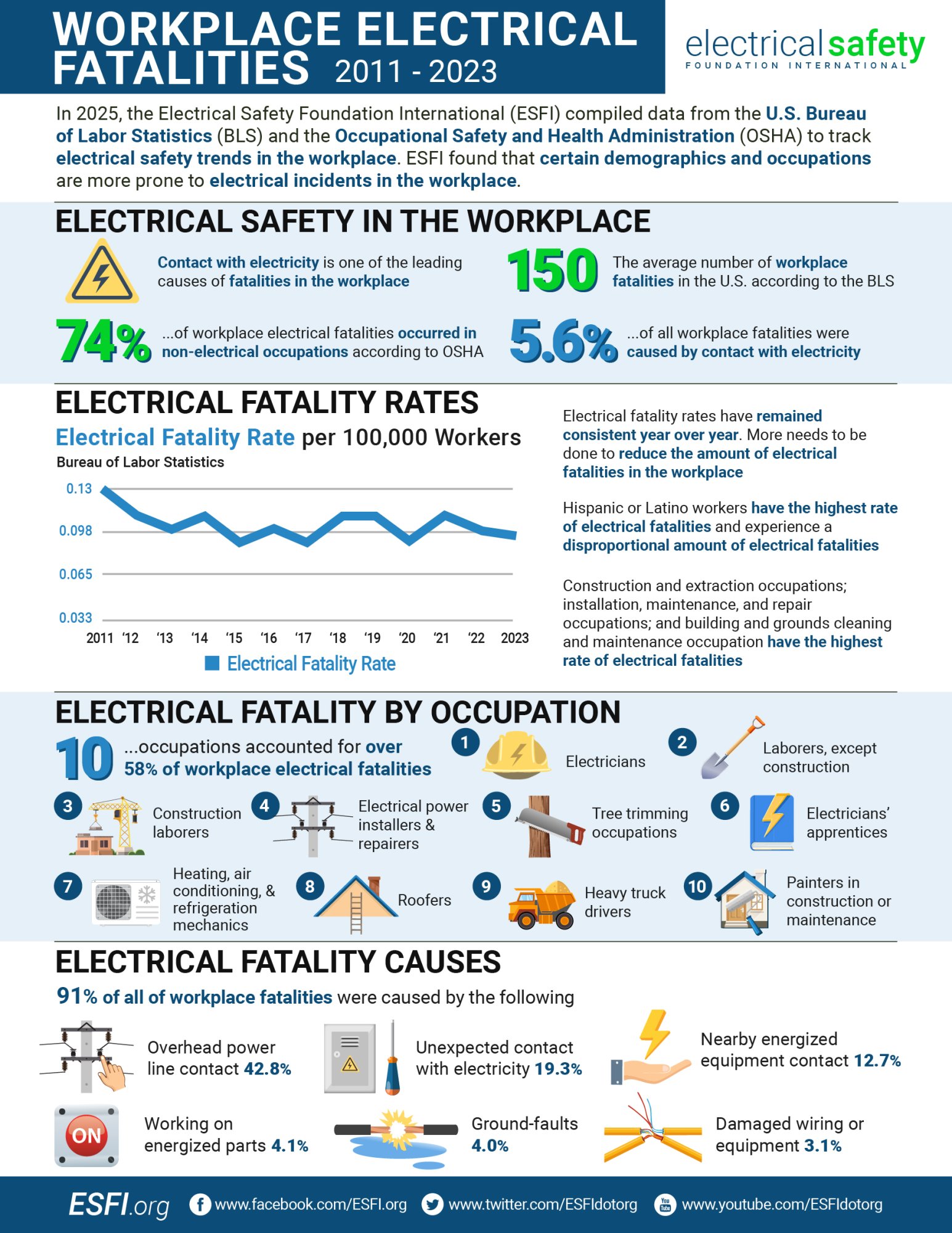ARLINGTON, Va (Feb. 5, 2025) — In 2025, the Electrical Safety Foundation International (ESFI) collected information on fatal and nonfatal occupational electrical injuries from every available source. The U.S. Bureau of Labor Statistics (BLS) and the Occupational Safety and Health Association (OSHA) provide raw data that ESFI reviews and analyzes as it is released to identify electrical safety trends. ESFI quantifies, synthesizes and publishes the information from these reports in visual form to its website. The most recent data set covers the 13 years from 2011 through 2023.

Contact with or exposure to electricity continues to be one of the leading causes of workplace fatalities and injuries in the U.S. Between 2011 and 2023, there was a total of 1,940 workplace fatalities involving electricity, according to the BLS. During this period, 74% of fatalities occurred in non-electrically related occupations. The key data points are as follows:
Workplace Fatalities & Injuries: 2011-23 (OSHA)
- 74% of workplace electrical fatalities occurred in non-electrical occupations.
- 26% percent of workplace electrical fatalities occurred in electrical occupations.
- 5.6% of all fatalities were caused by contact with electricity.
- Electrical fatalities continue to stay consistent year over year, with a slight downward trend since 2011.
- The construction industry had the highest number of electrical fatalities.
Occupations With the Most Electrical Fatalities (OSHA)
- Electricians: 212 fatalities
- Laborers, except construction: 142 fatalities
- Construction laborers: 131 fatalities
- Electrical power installers and repairers: 122 fatalities
- Tree trimming occupations: 64 fatalities
- Electricians’ apprentices: 45 fatalities
- HVAC and refrigeration mechanics: 43 fatalities
- Roofers: 38 fatalities
- Truck drivers, heavy: 35 fatalities
- Painters, construction and maintenance: 32 fatalities
Electrical Fatality Rates Per 100,000 Workers (BLS)
- Electrical fatality rates per 100,000 workers have remained consistent while overall fatality rates have increased.
- Hispanic or Latino workers have a disproportionately high rate of electrical fatalities, and that rate is increasing.
- Construction and extraction occupations, installation, maintenance and repair occupations, and building and grounds cleaning and maintenance occupations have the highest rate of electrical fatalities.
ESFI partners with industry leaders, including those comprising its board of directors, to develop key resources and consistent electrical safety messages. By addressing evolving and emerging electrical safety needs in the workplace and then deploying effective electrical safety materials and programs based on those needs, electrical injuries and fatalities can decrease through proper education of the workforce.
“Most of the electrical fatalities that occurred in the workplace were from accidental contact with electricity,” said Daniel Majano, ESFI program director who compiled the data. “It is important to always be aware of your surroundings when at a jobsite. Whether it’s to always look up to spot overhead power lines or knowing what might be energized around your jobsite, it is imperative to know all the possible contact points of electricity around you.” Majano added, “Also always know when to say when and make sure you’re trained and aware of any electrical hazards. Over 74% of the workplace electrical fatalities that occurred between 2011 and 2023 were in non-electrical occupations that may have not received electrical safety training.”
Visit esfi.org.
